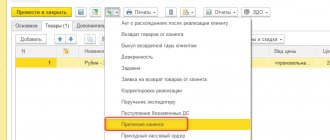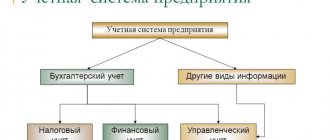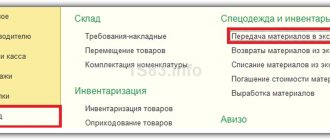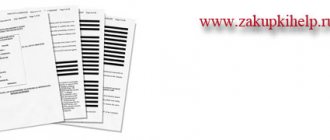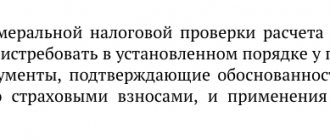Accounting and tax accounting of workwear
The term “working clothing” means personal protective equipment, which, in addition to clothing itself, includes safety shoes and protective equipment.
Normative base:
- Order of the Ministry of Finance No. 135n dated December 26, 2002;
- Order of the Ministry of Labor of Russia dated December 9, 2014 No. 997n;
- Order of the Ministry of Health and Social Development of Russia dated June 1, 2009 No. 290n;
- Information on standard standards for the free issuance of workwear, safety footwear and other personal protective equipment;
- Tax code;
- Labor Code (Articles 209, 221);
- Code of the Russian Federation on Administrative Offenses (Article 5.27.1 clause 4 – fine for officials from 20,000 to 30,000, for an organization from 130,000 to 150,000 rubles for failure to provide employees with special clothing).
The issuance of workwear at certain types of enterprises and for certain types of professions is established by law. The period of use and quantity of protective clothing issued are determined by industry standards or standard rules. Working clothes are issued to employees free of charge, but continue to remain the property of the employer; the costs of washing and cleaning them are borne by the enterprise. One of the important points: workwear must be certified.
Initially, Order No. 135n of the Ministry of Finance provided for the accounting of workwear as part of working capital. Two sub-accounts were opened on the Materials account:
- Overalls in the warehouse (in 1C this is account 10.10);
- Overalls in use (in 1C account 10.11).
Currently, it is allowed to apply PBU 6/01 “Accounting for fixed assets” (Letter N 16-00-14/159 of the Department of Accounting Methodology and Reporting of the Ministry of Finance of the Russian Federation dated May 12, 2003), but for this the service life of the workwear must be more than one year and the cost criterion fits the definition of a fixed asset.
Let's focus on the “traditional” approach, when workwear is taken into account on the 10th count. To correctly write off the cost of workwear as expenses, it is necessary to correctly determine its service life. Possible options:
- The service norm is no more than a year - costs in the control unit are fully taken into account in expenses at the time of transfer to operation;
- The service rate is more than a year - in accounting, the linear method of writing off expenses should be used over the entire service life of the clothing.
In NU, the cost of workwear is taken into account in expenses immediately (Article 254, paragraph 1, paragraph 3). As a result, temporary differences appear for income taxes (PBU 18/02).
A reservation should be made that, if desired, the taxpayer may not write off the cost at once, but reflect expenses in several reporting periods. In BU, it is also possible that when putting into operation workwear that has a service life of less than 12 months, do not immediately write off the entire cost, but do it using the straight-line method over the entire service life. The chosen procedure should be fixed in the accounting policy.
Workwear in use with a service life of more than a year is listed on account 10.11, wear and tear is written off monthly to the expense account. Off-balance sheet accounting is maintained for all issued workwear until disposal occurs as a result of wear and tear (or for another reason). In 1C, the off-balance sheet account MTs.02 Workwear in use is used.
After the entire cost from account 10.11 has been written off to BU expenses, the workwear should be written off from the balance sheet due to wear and tear. If an employee is fired or transferred to a position where special clothing is not needed, the employee must hand over the protective equipment issued to him to the enterprise. Our company provides 1C implementation and support services in Moscow. If you have any questions about working with the system, contact him, we will be happy to help you.
Write-off (issuance) of workwear in 1C 8.3
How to write off workwear in 1C 8.3? Issue workwear with the document Transfer of materials into operation in the section Warehouse - Workwear and equipment - Transfer of materials into operation.
Workwear tab with the donated workwear:
- An individual is an employee who has received special clothing;
- Purpose of use - the procedure for writing off workwear.
Postings
Accounting for workwear when dismissing employees
Quite often it happens that an employee quits (or moves to another department) and hands over the workwear before the depreciation period expires. Then you should create a document Return of materials from service. The tabular part can be automatically filled in according to the balances, and then only the names of the dismissed employees can be left.
The workwear will be returned to the account on 10.10, and the write-off of the cost as expenses will temporarily stop. Then it can be transferred to another employee according to the algorithm shown above.
It should be noted that the question of what to do with workwear if an employee quits and the residual value has not yet been written off is quite acute and does not have a single methodological solution. The situation above shows the simplest option. But sometimes workwear cannot be transferred to a new employee:
- For reasons of hygiene;
- Due to physical wear and tear;
- The overalls were custom-made for a specific employee.
There are also situations when, after the dismissal of an employee, accounting workers discovered that he had not handed over his workwear. The residual value has not been written off and remains on the balance sheet. What to do in such cases?
There is no single answer to the question of how such situations will affect the calculation of taxes (VAT, profit, personal income tax and insurance contributions). It is clear that the position of the tax authorities and the Ministry of Finance is aimed at increasing the tax burden on the enterprise. At the same time, judicial practice often speaks in favor of organizations that did not add additional taxes, from their point of view. Let's consider some options for action, without insisting that they are the only correct ones. The chief accountant of an enterprise must develop a strategy for action in such a situation and consolidate it in the accounting policy.
Let’s assume that the following situation arises in terms of amounts at the time of the employee’s dismissal:
| Dt | CT | Sum | Operation |
| 10.10 | 60 | 1 800 | The cost of the protective suit was capitalized |
| 19 | 60 | 324 | VAT credited |
| 68 | 19 | 324 | VAT is accepted for deduction |
| 10.11 | 10.10 | 1 800 | The suit was put into operation, wear period is 18 months |
| 20 | 10.11 | 1 000 | Depreciation of workwear was accrued for 10 months |
| 10.11 | 800 | Residual cost of workwear upon dismissal of an employee |
Below are a few examples of an employee’s actions and options for an accountant’s reaction to them:
| Dt | CT | Sum | Operation |
| 1. The employee handed over the workwear to the warehouse, but it cannot be issued again. The Inventory Commission generated a write-off act due to wear and tear. | |||
| 94 | 10.11 | 800 | The residual value of workwear has been written off |
| 91.2 | 94 | 800 | The cost of written-off workwear is included in non-operating expenses |
| 2. If the accountant in Example 1 decides that the costs written off to account 91.2 are not accepted for calculating income tax, and VAT must be restored additionally, then there will be more entries. In terms of profit, the constant difference is 160 rubles (800 rubles x 20%). Regarding VAT, theoretically there are two options: calculate the tax amount proportionally, as with separate accounting, and restore VAT in the amount of 144 rubles. (800 rub. x 18%). At the same time, it may be necessary to act with an eye to the provisions of the tax code, which states that VAT should be restored in proportion to the book value on fixed assets, but we have materials. Therefore, we need to decide for ourselves whether VAT should be restored in full from the amount of 324 rubles? | |||
| 99 | 68 | 160 | Permanent income tax difference |
| 19 | 68 | 144 (? 324) | VAT restored |
| 91.2 | 19 | 144 (? 324) | VAT is written off to non-operating expenses |
| 3. The employee did not hand over his work clothes; he has not yet received the final payment upon dismissal. The accountant decided to calculate the residual value of the clothes from wages. | |||
| 94 | 10.11 | 800 | The residual value of workwear has been written off |
| 73 | 94 | 800 | The cost of workwear has been transferred to payments to employees |
| 70 | 73 | 800 | The cost of workwear was repaid through salary accrual |
| It should be noted that if Example 3 is slightly changed, and the employee has already received a payment, then the cost of workwear can only be recovered through the court, because This is a kind of theft of company property. Here it is worth comparing the cost of the shortage and legal costs. | |||
| 4. The employee compensates the company for the residual cost of the workwear and keeps it for himself. He must do this voluntarily, submitting an application with a request to make a deduction from his salary. | |||
| 73 | 10.11 | 800 | The overalls were handed over to the employee |
| 70 | 73 | 800 | Debt is taken into account when calculating wages |
| 5. Example 4 causes heated debate between enterprises and tax authorities about whether VAT should be charged on the residual value of workwear when it is transferred to an employee. The regulatory authorities say that it is necessary, because... there is a transfer of ownership - this is a sale and VAT arises. The courts are inclined to believe that this situation is a reimbursement of costs, and VAT does not arise. If you reflect the transfer of workwear as a sale, then the following postings are possible: | |||
| 73 | 91.1 | 944 (800 + 144) | Non-operating income from the sale of workwear |
| 91.2 | 10.11 | 800 | The residual cost of workwear is taken into account in expenses |
| 91.2 | 68 | 144 | VAT |
| 70 | 73 | 944 | The employee's debt is taken into account when calculating wages |
| 6. When reflecting the transfer of workwear as a sale, not everything is clear with the price issue. Previously, we looked at examples in which residual value was taken into account for sales purposes. But what if it is necessary to sell based on market prices, and it is necessary to make some kind of markup? Let’s say right away that when selling workwear with a markup and VAT, you will be freed from claims from inspectors, but whether this is beneficial for the enterprise and employees is a question. Let’s say the cost of clothing without VAT is equal to 1,000 rubles, then the postings will be as follows: | |||
| 73 | 91.1 | 1 180 (1 000 + 180) | Non-operating income from the sale of workwear |
| 91.2 | 10.11 | 1 000 | The residual cost of workwear is taken into account in expenses |
| 91.2 | 68 | 180 | VAT |
| 70 | 73 | 1 180 | The employee's debt is taken into account when calculating wages |
We have considered a far from complete list of questions that an accountant may have when handing over workwear to employees. For example, it is possible to formalize such an operation as a gratuitous transfer. VAT then still arises, and the employee will most likely have to pay personal income tax on material benefits at a rate of 35%.
Seeing the range of issues related to the residual cost of protective equipment when dismissing employees, it becomes clear the approach of gradually writing off as expenses even those workwear that have a service life of less than a year, especially in conditions of high staff turnover.
It is clear that it is impossible to show the entire range of 1C user actions in one article with so many options; a book or qualified assistance from a consultant is needed here. Understanding the complexity of the choice, we can propose to decide on a plan of action in such situations and record the found algorithm in the accounting policy. That is, having previously compiled a list of transactions and amounts that should ultimately be received, contact 1C consultants to reflect this situation in the 1C: Accounting program.
Repayment of the cost of workwear in 1C 8.3
The repayment parameters are set:
- for used equipment - in the document Transfer of materials into operation ;
- for NU - in the accounting policy settings.
Monthly repayment of the cost occurs when performing the procedure Closing the month with the operation Repayment of the cost of workwear and special equipment 1C 8.3, section Operations - Closing the period - Closing the month.
The women's "Safari" utility robe was issued to the employee on August 20. Therefore, repayment of the cost begins from September.
The cost is repaid in the same way for the following months until it is fully repaid. When disposing of (returning) workwear, the cost is repaid for the last month in the disposal document, for example, in the document Return of materials from service .
Calculation of monthly amount:
The monthly amount by which the cost of workwear is repaid is calculated correctly in 1C.
Uniform accounting
A little about uniform and its differences from special clothing. Workwear is a means of protection, and despite the ambiguity of accounting issues during dismissal, for many others it has a clear framework outlined by the current legislation. In addition, there is such a thing as uniforms. It serves to identify an employee as a person belonging to a certain organization or structure. For many professions, wearing a uniform is required by law. Many organizations introduce uniforms in the workplace to improve the quality and speed of customer service and to create the company's image.
Issues of accounting for uniforms are not always covered by the tax code, and the positions of regulatory authorities are not always coherent and uniform. It should be noted that two options are possible:
- The form is issued to the employee for the duration of his work and is the property of the company;
- The uniform becomes the property of the employee and remains in his possession after dismissal.
In the first case, expenses are taken into account as material costs, in the second, such transfer is reflected as wages with personal income tax. If the issuance of the form is required by law, insurance premiums do not need to be made; otherwise, insurance premiums will be charged. If you regularly have questions, our 1C technical support specialists will be happy to help you. Just call or leave a request on the website, we will contact you as soon as possible.
